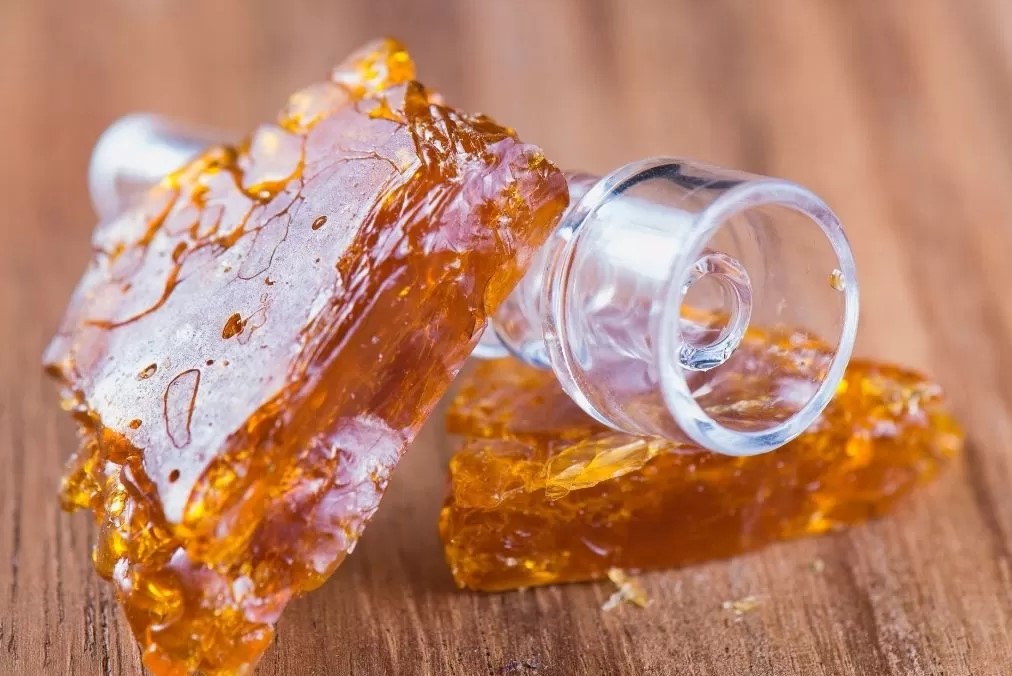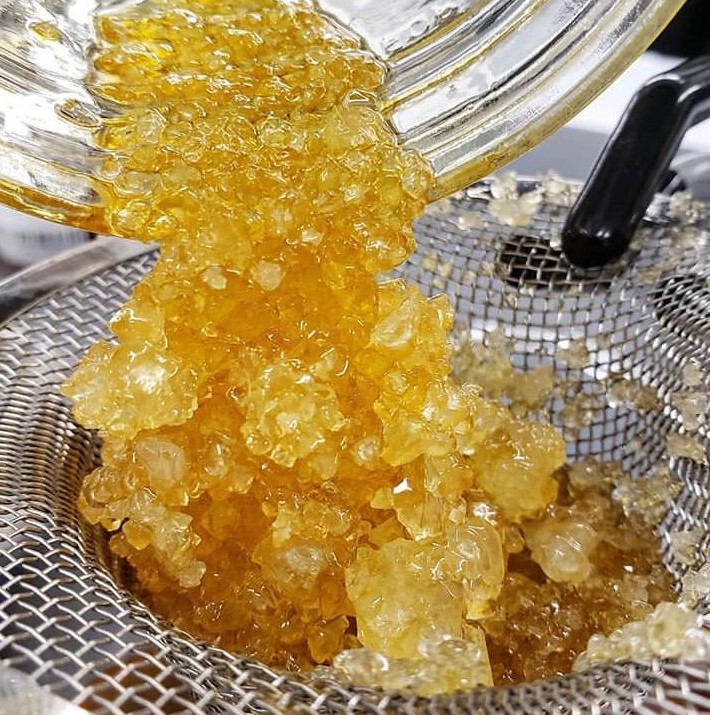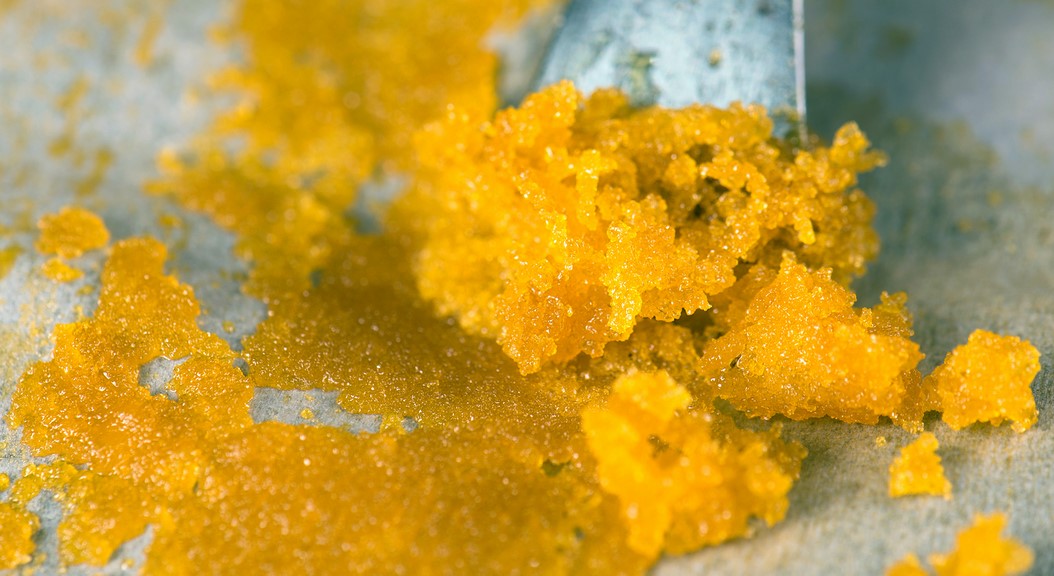Live resin is a relatively recent addition to the cannabis world, and it’s one of many several sorts of cannabis concentrate or extractions. Consumers and producers alike have embraced it because it keeps the tastes and smells of the living plant better than other cannabis extracts, as well as being less expensive and easier to make.

Resins that have been allowed to rest tend to have a more complex terpene profile and offer a more developed experience.
What is live resin?
Some concentrate textures or consistencies include shatter, wax, batter, and sauce. Live resin is a more malleable concentrate that sits somewhere between a wax and a sauce in texture and consistency—not quite like taffy but not too wet either.
It is generally a dark yellow color, but it can range from light yellow to white. It’s as sticky as all cannabis concentrates, so you’ll need a dab tool to handle it.
Live resins, on the other hand, are more powerful and have a higher THC concentration. Consumers enjoy it since to its strong tastes and scents that remain from the plant’s original form.

How to make live resin
Fresh frozen cannabis is used to make Releaf’s resin, which differs from other types of cannabis concentrates since it is manufactured using fresh frozen plants—plants that are immediately frozen after being cut down at harvest. These plants are kept frozen throughout the extraction procedure and avoid the drying, curing, and trimming phases of harvesting.
Terpenes, the plant’s flavor and aroma chemicals, can be sorely damaged by the drying and curing processes that cannabis plants generally undergo. Terpenes are found in trichomes, which cover buds as well as surrounding foliage.
Drying and curing cause the moisture and chlorophyll to depart from the plant. This may expose trichomes to heat, oxygen, and light, all of which can damage terpenes. Trichomes are also more prone to break off a plant while it is being handled and transported during harvesting.
Trichomes are left in live resin when they are frozen immediately after harvest, preserving the cannabis plant’s valuable terpene profile, original flavor, and scent throughout the extraction process and into the finished product.
Frozen plants are subjected to a solvent extraction method, which includes butane, propane, or another solvent, after harvesting.
After harvest, here are the steps for creating live resin:
- Freeze plants/plant matter
- Extract the oil
- Process into live resin
During the extraction process, the plants are kept at extremely low temperatures. Live resin is frequently warmed in a vacuum oven after extraction. It may be sold as-is or put into vape carts.
Cured resin vs. live resin
The primary difference between these two concentrates is in the starting material: Cured resin is made from dried plant material, whereas live resin is produced from frozen plant material that is maintained frozen throughout the extraction process.
A cure is a process in which resin from cannabis that has been dried and cured is extracted, after which it can be reformulated into shatter, wax, batter, or other types of concentrates.
Live resin vs. live rosin
Frozen cannabis plants are put through a solvent extraction to make resin, which is commonly made from butane or propane. Live rosin is solventless; it’s commonly produced by pressing the plant to remove trichomes with heat and pressure.
Extracts from both cacti are “live,” since they both derive their material from frozen cannabis plants. Some simple resins and rosins employ dried plant, rather than frozen, extraction techniques, as well as solvent and solventless extraction processes.
Live resin vs. distillate
A concentrated cannabis liquid that is produced when a resin is refined to remove contaminants or isolate a specific chemical, as in the case of distillate. Because live resin is used, it does not utilize frozen cannabis plants as its basis material.
Distillate, as a result of its lower boiling point and shorter chain, has little terpenes and hence no smell, taste, or flavor when produced. Some customers may prefer this bland flavor in a vape cart over the flavorful live resin, but it is very different from it.
Benefits of live resin
Dabbers prefer live resin because it is more flavorful and “terpy” than other concentrates. Because it keeps the flavor profile of the original marijuana plant while preserving trichomes and terpenes, it also helps to keep the cannabinoids intact. Live resin is also highly potent, according to some users.
Growers also like to produce live resin plants. Growers don’t have to go through the lengthy, difficult processes of drying, curing, and trimming plants—whole plants may be chopped down, frozen, and sent straight to the extractor—when fresh freezing harvested plants at harvest. Saving farmers hours, effort, and money by creating living resin vegetation is a huge time-saver for them.

How to use live resin
Dabbing
The most common method of consuming live resin is dabbing. You’ll need a dab rig, torch, and nail or an e-nail or e-rig to do so. To apply the concentrate to the nail, you’ll probably want something with a scoop on it, given live resin’s goopy texture.
Vaping with a dab pen or cart
You can also use a dab pen to hold live resin, which is essentially an e-rig for dabs that allows you to control heat and dab on the go. To get the live resin into the oven or bowl of the dab pen, use a dabber tool. Then simply adjust the temperature, push the button, and breathe in as normal.
Resin vapes are also available as disposable cartridges, much like e-liquids. Simply attach the cartridge to a battery, wait for it to reach temperature, and puff away.
Topping off
You may also cover a bowl, joint, or blunt with live resin for an extra kick.
Is live resin dangerous to consume?
To guarantee that goods fulfill state-mandated health standards, we recommend that all dabbers purchase them from a legitimate market’s licensed producer. Live resin must be purged of solvents before it can be sold, and it may only contain a certain amount of residual solvent.
Dabs, extracts, and live resin bought through a legitimate market are all just as safe to consume as each other. Live resin must be vaped or dabbed in a vape pen, and it cannot be eaten. It is considerably more concentrated than flower and takes a little bit to go a long way.
How to store live resin
Keep live resin cool and in an airtight container, ideally in the fridge if possible. These will keep it smelling and tasting delicious for a long time. Terpenes are best stored in an airtight container, such as a mason jar or Secure. To preserve the terpenes, leave it out in the open with the lid off and expose it to air, light, and heat. This will also cause it to dry up and harden, making it difficult to handle.
How much does live resin cost?
Resin has come a long way in a few years. Only a few years ago, it was a new and unusual product that could cost upwards of $100 per gram in specialty shops.
Live resin is still more costly than other concentrates, but today’s prices are far more reasonable, and most dispensaries provide a selection of alternatives.
On the low end, live resins typically cost between $20 and $30 per gram, while on the high side they can cost as much as $50 per gram.
How are live resins different from one another?
Resins can differ in consistency, although they generally sit between waxes and sauces.
The amount of terpenes in a live resin can alter the viscosity, and some only contain lighter terpenes such as pinene and myrcene. Because certain extraction methods miss out on certain terpenes, variations may occur. Live sugar is crumblier and is considered to have less terpenes, for example.
Concentrates can also be modified by hand, such as when saps are whipped into butters and transformed to different consistencies.
Where did live resin originate?
Cannabis resin is a relatively recent invention. Its origins date back to 2011 and 2013, when a small number of farmers and extractors in Colorado began using it.
As a result, many live resin extractors on the market are simply variations of this design. One such device was designed by William Fenger, also known as “Kind Bill,” and EmoTek Labs creator “Giddy Up,” who developed a specialized BHO extractor that can keep temperatures low enough to produce live resin.
They were also able to keep terpenes, taste, and fragrance throughout the extraction process by combining them.
